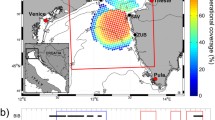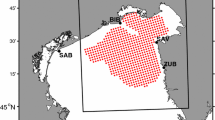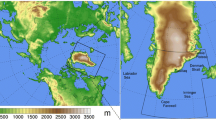Abstract
We performed a number of sensitivity experiments by applying a mapping technique, self-organizing maps (SOM) method, to the surface current data measured by high-frequency (HF) radars in the northern Adriatic and surface winds modelled by two state-of-the-art mesoscale meteorological models, the Aladin (Aire Limitée Adaptation Dynamique Développement InterNational) and the Weather and Research Forecasting models. Surface current data used for the SOM training were collected during a period in which radar coverage was the highest: between February and November 2008. Different pre-processing techniques, such as removal of tides and low-pass filtering, were applied to the data in order to test the sensitivity of characteristic patterns and the connectivity between different SOM solutions. Topographic error did not exceed 15 %, indicating the applicability of the SOM method to the data. The largest difference has been obtained when comparing SOM patterns originating from unprocessed and low-pass filtered data. Introduction of modelled winds in joint SOM analyses stabilized the solutions, while sensitivity to wind forcing coming from the two different meteorological models was found to be small. Such a low sensitivity is considered to be favourable for creation of an operational ocean forecasting system based on neural networks, HF radar measurements and numerical weather prediction mesoscale models.
Similar content being viewed by others
References
Kohonen, T.: Self-organized information of topologically correct features maps. Biol. Cybern. 43, 59–69 (1982)
Kohonen, T.: : Self-Organizing Maps, Springer Series Information Science, 3rd, vol. 30, p 501. Springer, New York (2001)
Vesanto, J., Alhoniemi, E.: Clustering of the self-organizing map. IEEE Trans. Neural Netw. 11, 586–600 (2000)
Fritzke, B.: Growing cell structures—a self-organizing network for unsupervised and supervised learning. Neural Netw. 7, 1441–1460 (1994)
Kohonen, T., Oja, E., Simula, O., Visa, A., Kangas, J.: Engineering applications of the self-organizing map. IEEE Proc. 84, 1358–1384 (1996)
Herrero, J., Valencia, A., Dopazo, J.: A hierarchical unsupervised growing neural network for clustering gene expression patterns. Bioinformatics 17, 126–136 (2001)
Xu, R, Wunsch, D.: Survey of clustering algorithms. IEEE Trans. Neural Netw. 16, 645–678 (2005)
Kolehmainen, M., Martikainen, H., Ruuskanen, J.: Neural networks and periodic components used in air quality forecasting. Atmos. Environ. 35, 815–825 (2001)
Fan, S., Chen, L.N.: Short-term load forecasting based on an adaptive hybrid method. IEEE Trans. Power Syst. 21, 392–401 (2006)
Cavazos, T.: Using self-organizing maps to investigate extreme climate events: an application to wintertime precipitation in the Balkans. J. Clim. 13, 1718–1732 (2000)
Hewitson, B.C., Crane, R.G.: Self-organizing maps: applications to synoptic climatology. Clim. Res. 22, 13–26 (2002)
Huth, R., Beck, C., Philipp, A., Demuzere, M., Ustrnul, Z., Cahynova, M., Kysely, J., Tveito, O.E.: Classifications of atmospheric circulation patterns recent advances and applications. Trends Dir. Clim. Res. 1146, 105–152 (2008)
Richardson, A.J., Risien, C., Shillington, F.A.: Using self-organizing maps to identify patterns in satellite imagery. Prog. Oceanogr. 59, 223–239 (2003)
Mau, J.C., Wang, D.P., Ullman, D.S., Codiga, D.L.: Characterizing Long Island Sound outflows from HF radar using self-organizing maps. Estuar. Coast. Shelf Sci. 74, 155–165 (2007)
Richardson, A.J., Pfaff, M.C., Field, J.G., Silulwane, N.F., Shillington, F.A.: Identifying characteristic chlorophyll a profiles in the coastal domain using an artificial neural network. J. Plankton Res. 24, 1289–1303 (2002)
Lee, Y.J., Lwiza, K.M.M.: Characteristics of bottom dissolved oxygen in Long Island Sound. New York Estuar. Coastal Shelf Sci. 76, 187–200 (2008)
Gutierrez, J.M., Cano, R., Cofino, A.S., Sordo, C.: Analysis and downscaling multi-model seasonal forecasts in Peru using self-organizing maps. Tellus A 57, 435–447 (2005)
Allen, J.I., Somerfield, P.J., Gilbert, F.J.: Quantifying uncertainty in high-resolution coupled hydrodynamic-ecosystem models. J. Mar. Syst. 64, 3–14 (2007)
Liu, Y., Weisberg, R.H., Mooers, C.N.K.: Performance evaluation of the self-organizing map for feature extraction. J. Geophys. Res. 111, C05018 (2006). doi:10.1029/2005JC003117
Liu, Y., Weisberg, R.H., Shay, L.K.: Current patterns on the West Florida shelf from joint self-organizing map analyses of HF radar and ADCP data. J. Atmos. Ocean. Technol. 24, 702–712 (2007)
Mihanović, H., Cosoli, S., Vilibić, I., Ivanković, D., Dadić, V., Gačić, M.: Surface current patterns in the northern Adriatic extracted from high frequency radar data using self-organizing map analysis. J. Geophys. Res. 116, C08033 (2011). doi:10.1029/2011JC007104
Essen, H.H., Gurgel, K.-W., Schlick, T.: On the accuracy of current measurements by means of HF radar. IEEE J. Ocean. Eng. 25, 472–480 (2000)
Kim, S.Y., Terrill, E.J., Cornuelle, B.D., Jones, B., Washburn, L., Moline, M.A., Paduan, J.D., Garfield, N., Largier, J.L., Crawford, G., Kosro, P.M.: Mapping the U.S. West Coast surface circulation: a multiyear analysis of high-frequency radar observations. J. Geophys. Res. 116, C03011 (2011). doi:10.1029/2010JC006669
Paduan, J.D., Washburn, L.: High-frequency radar observations of ocean surface currents. Ann. Rev. Mar. Sci. 5, 115–136 (2013)
Kirincich, A.R., Lentz, S.J., Farrar, J.T., Ganju, N.K.: The spatial structure of tidal and mean circulation over the inner shelf south of Martha’s Vineyard, Massachusetts. J. Phys. Oceanogr. 43, 1940–1958 (2013)
Shay, L.K., Graber, H.C., Ross, D.B., Chapman, R.D.: Mesoscale ocean surface current structure detected by high-frequency radar. J. Atmos. Ocean. Technol. 12, 881–900 (1995)
Gough, M.K., Garfield, N., McPhee-Shaw, E.: An analysis of HF radar measured surface currents to determine tidal, wind-forced, and seasonal circulation in the Gulf of the Farallones, California, United States. J. Geophys. Res. 115, C04019 (2010). doi:10.1029/2009JC005644
Gurgel, K.W., Dzvonkovskaya, A., Pohlmann, T., Schlick, T., Gill, E.: Simulation and detection of tsunami signatures in ocean surface currents measured by HF radar. Ocean Dyn. 61, 1495–1507 (2011)
Kovačević, V., Gačić, M., Mazzoldi, A., Dallaporta, G., Gaspari, A.: Sea-surface currents measured by coastal HF radar offshore Ancona. Boll. Geofis. Teor. Appl. 41, 339–355 (2000)
Chavanne, C., Janeković, I., Flament, P., Poulain, P.M., Kuzmić, M., Gurgel, K.W.: Tidal currents in the northwestern Adriatic: high-frequency radio observations and numerical model predictions. J. Geophys. Res. 112, C03S21 (2007). doi:10.1029/2006JC003523
Cosoli, S., Mazzoldi, A., Gačić, M.: Validation of surface current measurements in the northern Adriatic Sea from high-frequency radars. J. Atmos. Ocean. Technol. 27, 908–919 (2010)
Cosoli, S., Gačić, M., Mazzoldi, A.: Surface current variability and wind influence in the northeastern Adriatic Sea as observed from high-frequency (HF) radar measurements. Cont. Shelf Res. 33, 1–13 (2012)
Cosoli, S., Ličer, M., Vodopivec, M., Malačič, V.: Surface circulation in the Gulf of Trieste (northern Adriatic Sea) from radar, model, and ADCP comparisons. J. Geophys. Res. Oceans 118, 6183–6200 (2013)
Orlić, M., Dadić, V., Grbec, B., Leder, N., Marki, A., Matić, F., Mihanović, H., Beg Paklar, G., Pasarić, M., Pasarić, Z., Vilibić, I.: Wintertime buoyancy forcing, changing seawater properties and two different circulation systems produced in the Adriatic. J. Geophys. Res. 111, C03S07 (2006). doi:10.1029/2005JC003271
Campanelli, A., Grilli, F., Paschini, E., Marini, M.: The influence of an exceptional Po River flood on the physical and chemical oceanographic properties of the Adriatic Sea. Dyn. Atmos. Oceans 52, 284–297 (2011)
Mihanović, H., Vilibić, I., Carniel, S., Tudor, M., Russo, A., Bergamasco, A., Bubić, N., Ljubešić, Z., Viličić, D., Boldrin, A., Malačič, V., Celio, M., Comici, C., Raicich, F.: Exceptional dense water formation on the Adriatic shelf in the winter of 2012. Ocean Sci. 9, 561–572 (2013)
Grisogono, B., Belušić, D.: A review of recent advances in understanding the meso and microscale properties of the severe Bora wind. Tellus A 61, 1–16 (2009)
Janeković, I., Kuzmić, M.: Numerical simulation of the Adriatic Sea principal tidal constituents. Ann. Geophys. 23, 3207–3218 (2005)
Prtenjak, M.T., Grisogono, B.: Sea/land breeze climatological characteristics along the northern Croatian Adriatic coast. Theor. Appl. Climatol. 90, 201–215 (2007)
Allard, R., Rogers, E., Martin, P., Jensen, T., Chu, P., Campbell, T., Dykes, J., Smith, T., Choi, J., Gravois, U.: The US Navy coupled ocean-wave prediction system. Oceanography 27, 92–103 (2014)
Barth, A., Alvera-Azcarate, A., Gurgel, K.W., Staneva, J., Port, A., Beckers, J.M., Stanev, E.V.: Ensemble perturbation smoother for optimizing tidal boundary conditions by assimilation of high-frequency radar surface currents—application to the German Bight. Ocean Sci. 6, 161–178 (2010)
Wahle, K., Stanev, E.V.: Consistency and complementarity of different coastal ocean observations: a neural network-based analysis for the German Bight. Geophys. Res. Lett. 38, L10603 (2013). doi:10.1029/2011GL047070
Thomson, R.E., Emery, W.J. Data Analysis Methods in Physical Oceanography, 3rd. Elsevier Science, Amsterdam, London, New York (2014)
Gurgel, K.W., Essen, H.H., Kingsley, S.P.: HF radars: physical limitations and recent developments. Coast. Eng. 37, 201–218 (1999)
Crombie, D.D.: Doppler spectrum of sea echo at 13.56 Mc/s. Nature 175, 681–682 (1955)
Kohut, J.T., Glenn, S.M.: Improving HF radar surface current measurements with measured antenna beam patterns. J. Atmos. Ocean. Technol. 20, 1303–1316 (2003)
Cosoli, S., Bolzon, G., Mazzoldi, A.: A real-time and offline quality control methodology for SeaSonde high-frequency radar currents. J. Atmos. Ocean. Technol. 29, 1313–1328 (2012)
Lipa, B.J., Barrick, D.: Least-squares methods for the extraction of surface currents from Codar crossed-loop data – application at ARSLOE. IEEE J. Ocean. Eng. 8, 226–253 (1983)
Barrick, D.E., Lipa, B.J.: An evaluation of least-squares and closed-form dual-angle methods for CODAR surface-current applications. IEEE J. Ocean. Eng. 11, 322–326 (1986)
Chapman, R.D., Graber, H.C.: Validation of HF radar measurements. Oceanography 10(2), 76–79 (1997)
Kovačević, V., Gačić, M., Mancero Mosquera, I., Mazzoldi, A., Marinetti, S.: HF radar observations in the northern Adriatic: surface current field in front of the Venetian Lagoon. J. Mar. Syst. 51, 95–122 (2004)
de Paolo, T., Terrill, E.: Skill assessment of resolving ocean surface current structure using compact-antenna-style HF radar and the MUSIC direction-finding algorithm. J. Atmos. Ocean. Technol. 24, 1277–1300 (2007)
Aladin International Team: The ALADIN project: mesoscale modelling seen as a basic tool for weather forecasting and atmospheric research. WMO Bull. 46, 317–324 (1997)
Tudor, M., Ivatek-Šahdan, S., Stanešić, A., Horvath, K., Bajić, A.: Forecasting weather in Croatia using ALADIN numerical weather prediction model. In: Zhang, Y., Ray, P. (eds.) Climate Change and Regional/Local Responses, pp 59–88. InTech, Rijeka (2013)
Ivatek-Šahdan, S., Tudor, M.: Use of high-resolution dynamical adaptation in operational suite and research impact studies. Meteorol. Z. 13(2), 1–10 (2004)
Tudor, M., Ivatek-Šahdan, S.: The case study of bura of 1st and 3rd February 2007. Meteorol. Z. 19, 453–466 (2012)
Geleyn, J.-F.: Interpolation of wind, temperature and humidity values from model levels to the height of measurement. Tellus 40A, 347–351 (1988)
Skamarock, W.C., Klemp, J.B., Dudhia, J., Gill, D.O., Barker, D.M., Duda, M.G., Huang, X.Y., Wang, W., Powers, J.G.: A description of the advanced research WRF Version 3, NCAR Technical Note NCAR/TN–475 + STR (2008)
Davies, H.C.: A lateral boundary formulation for multi-level prediction models. Q. J. Royal Meteorol. Soc. 102, 405–418 (1976)
Mlawer, E.J., Taubman, S.J., Brown, P.D., Iacono, M.J., Clough, S.A.: Radiative transfer for inhomogeneous atmospheres: RRTM, a validated correlated-k model for the longwave. J. Geophys. Res. 102(D14), 16663–16682 (1997)
Dudhia, J.: A multi-layer soil temperature model for MM5, pp 49–50. The Sixth PSU/NCAR MM5 Users’ Workshop, Boulder, Colorado (1996)
Hong, S.Y., Dudhia, J., Chen, S.H.: A revised approach to ice microphysical processes for the bulk parameterization of clouds and precipitation. Mon. Weather Rev. 132, 103–120 (2004)
Dudhia, J.: Numerical study of convection observed during the winter monsoon experiment using a mesoscale two-dimensional model. J. Atmos. Sci. 46, 3077–3107 (1989)
Hong, S.Y., Noh, Y., Dudhia, J.: A new vertical diffusion package with an explicit treatment of entrainment processes. Mon. Weather Rev. 134, 2318–2341 (2006)
žagar, N., Honzak, L., žabkar, R., Skok, G., Rakovec, J., Ceglar, A.: Uncertainties in a regional climate model in the mid-latitudes due to the nesting technique and the domain size. J. Geophys. Res. 118, 6189–6199 (2013)
Ceglar, A., Honzak, L., žagar, N., Skok, G., žabkar, R., Rakovec, J.: Evaluation of precipitation in the ENSEMBLES regional climate models over the complex orography of Slovenia. Int. J. Clim. 35, 2574–2591 (2014). doi:10.1002/joc.4158
Kriesel, D.: A brief introduction to neural networks, available at http://www.dkriesel.com, (2007). Accessed 3 December 2014
Liu, Y., Weisberg, R.H.: A review of self-organizing map applications in meteorology and oceanography. In: Mwasiagi, J.I. (ed.) Self-Organizing Maps-Applications and Novel Algorithm Design, pp 253–272. InTech, Rijeka (2011)
Kaski, S., Kangas, J., Kohonen, T.: Bibliography of self-organizing map (SOM) papers: 1981-1997. Neural Comput. Surv. 1, 102–350 (1998)
Oja, M., Kaski, S., Kohonen, T.: Bibliography of self-organizing map (SOM) papers: 1998–2001 addendum. Neural Comput. Surv. 3, 1–156 (2003)
Hewitson, B.C., Crane, R.G.: Neural Nets: Applications in Geography. Springer, New York (1994)
Schuenemann, K.C., Cassano, J.J., Finnis, J.: Forcing of precipitation over Greenland: synoptic climatology for 1961-99. J. Hydrometeorol. 10, 60–78 (2009)
Tambouratzis, T., Tambouratzis, G.: Meteorological data analysis using self-organizing maps. Int. J. Intell. Syst. 23, 735–759 (2008)
Yip, Z.K., Yau, M.K.: Application of artificial neural networks on North Atlantic tropical cyclogenesis potential index in climate change. J. Atmos. Ocean. Technol. 29, 1202–1220 (2012)
Iskandar, I.: Seasonal and interannual patterns of sea surface temperature in Banda Sea as revealed by self-organizing map. Cont. Shelf Res. 30, 1136–1148 (2010)
Hong, Y., Chiang, Y.M., Liu, Y., Hsu, K.L., Sorooshian, S.: Satellite-based precipitation estimation using watershed segmentation and growing hierarchical self-organizing map. Int. J. Remote Sens. 27, 5165–5184 (2006)
Liu, Y., Weisberg, R.H.: Patterns of ocean current variability on the West Florida Shelf using the self-organizing map. J. Geophys. Res. 110, C06003 (2005). doi:10.1029/2004JC002786
Kropp, J., Klenke, T.: Phenomenological pattern recognition in the dynamical structures of tidal sediments from the German Wadden Sea. Ecol. Modell. 103, 151–170 (1997)
Bandelj, V., Socal, G., Park, Y.S., Lek, S., Coppola, J., Camatti, E., Capuzzo, E., Milani, L., Solidoro, C.: Analysis of multitrophic plankton assemblages in the Lagoon of Venice. Mar. Ecol. Prog. Ser. 368, 23–40 (2008)
Solidoro, C., Bastianini, M., Bandelj, V., Codermatz, R., Cossarini, G., Melaku Canu, D., Ravagnan, E., Salon, S., Trevisani, S.: Current state, scales of variability & trends of biogeochemical properties in the northern Adriatic Sea. J. Geophys. Res. 114, C07S91 (2009). doi:10.1029/2008JC004838
Vesanto, J., Himberg, J., Alhoniemi, E., Parhankangas, J.: SOM Toolbox for Matlab 5, Technical Report A57, FIN-02015 HUT, p 59. Helsinki University of Technology, Helsinki (2000)
Malačič, V., Viezzoli, D., Cushman-Roisin, B.: Tidal dynamics in the northern Adriatic Sea. J. Geophys. Res. 105, 26265–26280 (2000)
Cushman-Roisin, B., Naimie, C.E.: A 3D finite-element model of the Adriatic tides. J. Mar. Syst. 37, 279–297 (2002)
Pawlowicz, R., Beardsley, B., Lentz, S.: Classical tidal harmonic analysis including error estimates in MATLAB using T_TIDE. Comput. Geosci. 28, 929–937 (2002)
Raicich, F., Orlić, M., Vilibić, I., Malačič, V.: A case study of the Adriatic seiches (December 1997). Il Nuovo Cimento C 22, 715–726 (1999)
Krajcar, B., Orlić, M.: Seasonal variability of inertial oscillations in the northern Adriatic. Cont. Shelf Res. 15, 1221–1233 (1995)
Whiteman, C.D., Bian, X.D.: Solar semidiurnal tides in the troposphere: detection by radar profilers. Bull. Am. Meteorol. Soc. 77, 529–542 (1996)
Zhang, Z., Schwartz, S., Wagner, L., Miller, W.: A greedy algorithm for aligning DNA sequences. J. Comput. Biol. 7, 203–214 (2000)
Cormen, T.H., Leiserson, C.E., Rivest, R.L.: Introduction to Algorithms. MIT Press and McGraw-Hill (2009)
Kundu, P.K.: Ekman veering observed near the ocean bottom. J. Phys. Oceanogr. 6, 238–242 (1976)
Pasarić, Z., Belušić, D., Klaić, Z.B.: Orographic influences on the Adriatic sirocco wind. Ann. Geophys. 25, 1263–1267 (2007)
Cavaleri, L., Bertotti, L., Tescaro, N.: The modelled wind climatology of the Adriatic Sea. Theor. Appl. Climatol. 56, 231–254 (1997)
Malačič, V., Celio, M., Čermelj, B., Bussani, A., Comici, C.: Interannual evolution of seasonal thermohaline properties in the Gulf of Trieste (northern Adriatic) 1991-2003. J. Geophys. Res. 111, C08009 (2006). doi:10.1029/2005JC003267
Vilibić, I., Mihanović, H., Šepić, J., Matijević, S.: Using self-organising maps to investigate long-term changes in deep Adriatic water patterns. Cont. Shelf Res. 31, 695–711 (2011)
Pölzlbauer, G.: Survey and comparison of quality measures for self-organizing maps. In: Paralič, J, Pölzlbauer, G, Rauber, A (eds.) Proceedings of the Fifth Workshop on Data Analysis (WDA’04), pp 67–82. Elfa Academic Press, Vysoké Tatry, Slovakia
Jeffries, M.A., Lee, C.M.: A climatology of the northern Adriatic Sea’s response to bora and river forcing. J. Geophys. Res. 112, C03S02 (2007). doi:10.1029/2006JC003664
Lee, T.L., Jeng, D.S.: Application of artificial neural networks in tide-forecasting. Ocean Eng. 29, 1003–1022 (2002)
Makarynskyy, O.: Improving wave predictions with artificial neural networks. Ocean Eng. 31, 704–729 (2004)
Cowles, G.W.: Parallelization of the FVCOM coastal ocean model. Int. J. High Perform. Comput. Appl. 22, 177–193 (2008)
Haidvogel, D.B., Beckmann, A.: Numerical Ocean Circulation Modeling. Imperial College Press, London (1999)
Hall, D.: Rejuvenation, diversification and imagery: sustainability conflicts for tourism policy in the Eastern Adriatic. J. Sustain. Tour. 11, 280–294 (2009)
Ferraro, G., Bernardini, A., David, M., Meyer-Roux, S., Muellenhoff, O., Perkovic, M., Tarchi, D., Topouzelis, K.: Towards an operational use of space imagery for oil pollution monitoring in the Mediterranean basin: a demonstration in the Adriatic Sea. Mar. Pollut. Bull. 53, 403–422 (2007)
Author information
Authors and Affiliations
Corresponding author
Rights and permissions
About this article
Cite this article
Vilibić, I., Kalinić, H., Mihanović, H. et al. Sensitivity of HF radar-derived surface current self-organizing maps to various processing procedures and mesoscale wind forcing. Comput Geosci 20, 115–131 (2016). https://doi.org/10.1007/s10596-015-9550-3
Received:
Accepted:
Published:
Issue Date:
DOI: https://doi.org/10.1007/s10596-015-9550-3




